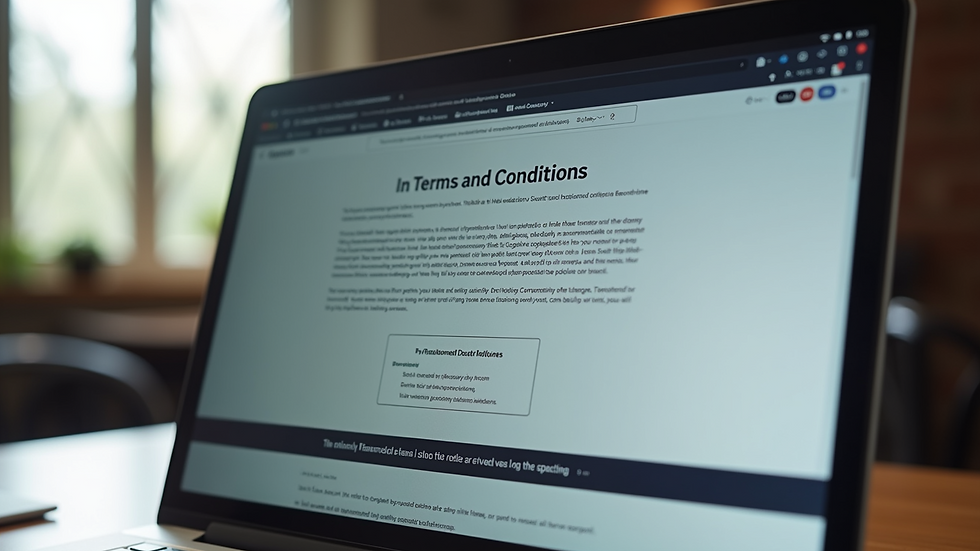Why Every Shopper Should Read Terms and Conditions
- kerriny
- Sep 3
- 4 min read
When shopping online or even in physical stores, many people skip reading the terms and conditions. These documents often seem long, boring, and full of legal jargon. However, understanding terms and conditions is crucial for every shopper. They protect your rights, inform you about your responsibilities, and clarify what you can expect from the seller. This terms guide will explain why reading these documents is essential and how it can save you from future problems.
The Importance of a Terms Guide for Shoppers
Terms and conditions are more than just legal formalities. They are agreements between you and the seller that outline the rules of the transaction. By reading them, you gain insight into:
Return and refund policies: Know if you can return a product and under what conditions.
Warranty details: Understand what is covered and for how long.
Payment terms: Learn about payment methods, billing cycles, and any extra fees.
Privacy policies: See how your personal data will be used and protected.
Dispute resolution: Find out how conflicts will be handled, whether through arbitration or court.
Ignoring these details can lead to surprises like non-refundable purchases, hidden charges, or loss of consumer rights. For example, some online stores may charge restocking fees or refuse returns on sale items. Without reading the terms, you might miss these important points.

How to Identify Key Points in a Terms Guide
Reading terms and conditions can be overwhelming, but focusing on key sections makes it manageable. Here’s how to approach it:
Look for headings and subheadings: These help you find important topics quickly.
Focus on return, refund, and cancellation policies: These affect your ability to get your money back.
Check payment and billing information: Understand when and how you will be charged.
Review privacy and data use clauses: Protect your personal information.
Note any disclaimers or limitations of liability: Know what the seller is not responsible for.
Understand dispute resolution methods: This tells you how problems will be solved.
Using this method, you can skim through the document and still catch the most critical information. If you want a detailed explanation, you can refer to a terms and conditions guide that breaks down common clauses in simple language.
How to Structure Terms and Conditions?
For businesses, structuring terms and conditions clearly is just as important as reading them for shoppers. A well-organized document helps customers understand their rights and obligations, reducing confusion and disputes. Here’s a simple structure that works well:
Introduction: Explain the purpose of the document and who it applies to.
Definitions: Clarify key terms used throughout the document.
User obligations: Outline what the customer must do or avoid.
Payment terms: Detail pricing, billing, and payment methods.
Delivery and shipping: Describe how and when products will be delivered.
Returns and refunds: State the conditions for returning items and getting refunds.
Warranties and disclaimers: Specify guarantees and limitations.
Privacy policy: Explain how customer data is collected and used.
Dispute resolution: Provide steps for handling conflicts.
Contact information: Offer ways to reach customer support.
This structure ensures that all essential topics are covered and easy to find. Clear terms and conditions build trust and improve the shopping experience.

Practical Tips for Shoppers When Reading Terms and Conditions
To make the most of your reading, follow these practical tips:
Take your time: Don’t rush through the document. Even a quick scan can miss important details.
Use a highlighter or notes: Mark sections that are relevant or confusing.
Ask questions: Contact customer service if something is unclear.
Compare terms: Look at terms from different sellers before making a purchase.
Keep a copy: Save the terms and conditions for future reference.
Watch for updates: Terms can change, so check them before each purchase.
For example, if you buy electronics, check the warranty period and what damages are covered. If you shop on a new website, verify their return policy to avoid losing money on unwanted items.
What Happens If You Don’t Read Terms and Conditions?
Skipping terms and conditions can lead to several issues:
Unexpected charges: You might be billed for subscriptions or fees you didn’t agree to.
No refunds: Some sellers have strict no-refund policies.
Loss of rights: You may waive your right to sue or participate in class actions.
Data misuse: Your personal information could be shared without your consent.
Delivery problems: You might miss important shipping deadlines or conditions.
For instance, many apps and online services include automatic renewals in their terms. Without reading, you could be charged repeatedly without realizing it. Being informed protects you from these pitfalls.

Empower Yourself with Knowledge
Reading terms and conditions is not just a formality - it is a way to protect yourself and make informed decisions. By understanding the rules of your purchase, you avoid surprises and ensure a smoother shopping experience. Use this terms guide to approach these documents confidently and safeguard your consumer rights.
Next time you shop, take a moment to read the terms and conditions carefully. It might seem tedious, but it is one of the smartest moves you can make as a shopper.




Comments